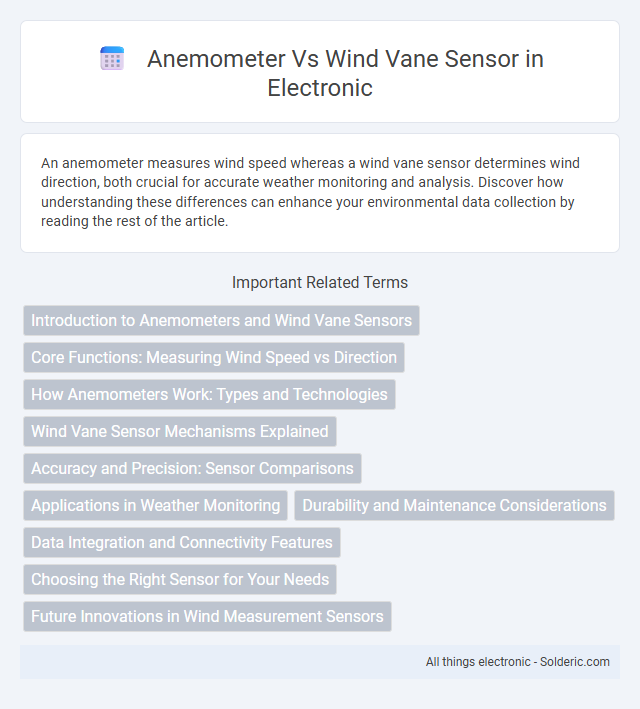An anemometer measures wind speed whereas a wind vane sensor determines wind direction, both crucial for accurate weather monitoring and analysis. Discover how understanding these differences can enhance your environmental data collection by reading the rest of the article.
Comparison Table
| Feature | Anemometer | Wind Vane Sensor |
|---|---|---|
| Purpose | Measures wind speed | Measures wind direction |
| Measurement Unit | Meters per second (m/s), kilometers per hour (km/h), miles per hour (mph) | Degrees (deg), compass points (N, NE, E, etc.) |
| Common Types | Cup anemometer, hot-wire anemometer, ultrasonic anemometer | Pole-mounted vane, electronic wind vane sensor |
| Operating Principle | Rotational speed of cups or sensors translates to wind velocity | Directional alignment with wind detected via potentiometer or magnetoresistive sensor |
| Output Signal | Analog pulses or voltage proportional to wind speed | Analog voltage or digital signal indicating wind angle |
| Applications | Weather stations, aviation, wind energy assessment | Meteorology, navigation, environmental monitoring |
| Accuracy | High for speed, affected by vibration and turbulence | High directional accuracy, dependent on sensor alignment |
Introduction to Anemometers and Wind Vane Sensors
Anemometers measure wind speed by detecting airflow velocity using spinning cups or ultrasonic waves, providing precise data for meteorological and industrial applications. Wind vane sensors determine wind direction by aligning a rotating pointer with the wind's flow, essential for accurate weather monitoring and navigation. Understanding your choice between anemometers and wind vane sensors ensures optimal environmental data collection tailored to your specific needs.
Core Functions: Measuring Wind Speed vs Direction
Anemometers are designed primarily to measure wind speed by capturing the velocity of moving air through rotating cups or ultrasonic sensors. Wind vane sensors focus on detecting wind direction by aligning with the airflow, typically using a rotating pointer balanced on a vertical axis. Both instruments are essential in meteorology but serve distinct roles by quantifying wind velocity versus directional bearing.
How Anemometers Work: Types and Technologies
Anemometers measure wind speed using rotating cups, propellers, or ultrasonic sensors to calculate airflow velocity, with cup anemometers detecting wind rotation speed and ultrasonic types measuring the time difference between sound pulses. There are three main types: cup, vane, and hot-wire anemometers, each utilizing mechanical or electronic principles for precise wind speed and direction data. Advanced ultrasonic anemometers offer no moving parts and greater accuracy by analyzing the propagation time of sound waves across multiple transducers.
Wind Vane Sensor Mechanisms Explained
Wind vane sensors operate by aligning a pivoted vane with the wind direction, using a mechanical design that allows it to rotate freely to indicate where the wind is coming from. The vane's orientation is converted into an electrical signal through sensors such as potentiometers or magnetic encoders, providing precise directional data for meteorological measurements. Your choice between an anemometer and a wind vane sensor depends on whether you need wind speed data or accurate wind direction readings.
Accuracy and Precision: Sensor Comparisons
Anemometers typically provide high accuracy and precision in measuring wind speed through rotating cups or ultrasonic sensors, making them ideal for quantifying airflow velocity with minimal error margins. Wind vane sensors prioritize accurately detecting wind direction but may lack the precision needed for speed measurement, as their mechanical design can introduce slight angular deviations. Your choice should consider that anemometers excel in accurate speed data, while wind vanes offer precise directional information, often requiring complementary use for comprehensive wind analysis.
Applications in Weather Monitoring
Anemometers and wind vane sensors play crucial roles in weather monitoring by measuring wind speed and direction, respectively. Anemometers are essential for tracking wind intensity during storms, aiding in forecasts and safety warnings, while wind vanes provide data on prevailing wind patterns critical for climate studies and atmospheric modeling. Their combined usage enhances the precision of meteorological data, supporting accurate weather predictions and environmental assessments.
Durability and Maintenance Considerations
Anemometers typically feature robust designs with fewer moving parts, resulting in higher durability and lower maintenance requirements compared to wind vane sensors, which often have delicate rotational components prone to wear and mechanical failure. Maintenance for wind vane sensors usually involves regular calibration and lubrication to ensure accurate wind direction readings, whereas anemometers primarily require occasional cleaning to prevent debris buildup that can affect wind speed measurement. Selecting an anemometer is advantageous for harsh environments due to its resilience and minimal upkeep demands, whereas wind vane sensors demand more frequent attention to maintain performance integrity.
Data Integration and Connectivity Features
Anemometer and wind vane sensors offer distinct data integration and connectivity capabilities critical for precise meteorological monitoring. Anemometers typically feature digital outputs such as pulse or analog voltage signals compatible with IoT platforms, enabling real-time wind speed data transmission and seamless integration with automated weather stations. Wind vane sensors often include RS-485 or Modbus communication protocols, facilitating accurate wind direction data collection and compatibility with remote monitoring systems for comprehensive environmental analysis.
Choosing the Right Sensor for Your Needs
Choosing the right sensor between an anemometer and a wind vane depends on whether you need precise wind speed or direction data. Anemometers measure wind speed accurately, making them essential for applications like weather stations and aviation safety. Wind vane sensors provide directional information to help you understand wind patterns and optimize positioning for wind turbines or outdoor equipment.
Future Innovations in Wind Measurement Sensors
Future innovations in wind measurement sensors will enhance accuracy, durability, and real-time data integration for both anemometers and wind vane sensors. Advanced materials and IoT connectivity will enable your wind monitoring systems to perform seamlessly in harsh environments, providing precise and actionable insights. Machine learning algorithms will optimize sensor calibration and predictive maintenance, revolutionizing wind energy management and meteorological applications.
Anemometer vs wind vane sensor Infographic

 solderic.com
solderic.com